The Way We Are, DIR. Ann Hui On-Wah (2008)
Tin Shui Wai, Yuen Long District, Hong Kong

The Way We Are, directed by Ann Hui in 2008, serenely portrays “normal” residents’ mundane but unique lives in Tin Shui Wai (TSW), a northwestern New Territories town in Hong Kong. It is known as the “City of Sadness,” described by the words: poverty and violence. However, the film presents another side of TSW—a friendly neighborhood. The main characters are residents: Guai, his son Ka-On, and new-comer Leung, an old woman without relatives. After daily interactions, their relationship becomes closer. TSW’s transportation and housing become props in the film.

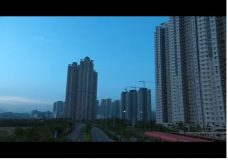
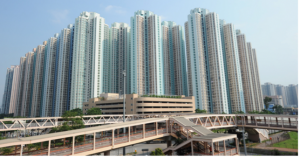
The film opens with old pictures (Figure2), revealing TSW’s development—it had changed from reclaimed fishponds to a new town1. A long-take shows the full-view of Tin Shui Wai New Town while comparing the old and new TSW. The camera starts from the operative light rail (Figure1) at dawn and horizontally moves to a high-rise residential complex (Figure3). Line 706 was constructed in 2004 mainly for local commuters which suggests that TSW is far from the city center. A public housing block implies that most residents are relatively low-income. Some housings are under-construction, compared with today’s TSW (Figure4) showing that TSW is still in the developing phase with hopes and vitality. In addition, the combination of housing complex, railway station, and skywalk is a typical new town planning stategy.
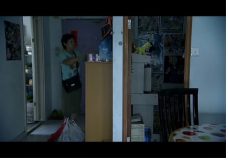
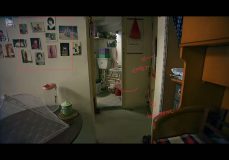
The interior functions as a narrative device2 rather than a setting. Lens zooms inside Guai’s home after the long-take, showing Ka-On got up lazily while Guai just got off her work. Ka-On didn’t realize the difficulties of his mum at the beginning which draws a comparison with himself in later period to show his growth. The shots: Guai stands by sideboard, presenting the room’s layout (Figure5). Compared with Leung’s room (Figure6), both rooms’ areas are small since the entrances only can accommodate one person. In Leung’s room, her bedroom is functioned as living room and dining room. It reveals that Leung is not a wealthy person but she bought gold jewelry as presents for Ka-On and Guai later, meaning that she treated them as her families. Space tells story.

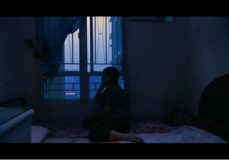
Window is a significant prop with different meanings. Initially, Leung turns her back to the window showing her loneliness. After having chances to visit her grandson, montage3 is adopted: she is too excited to fall asleep, so she are watching outside through the window (Figure7). In the film, opening the window represents that Leung’s heart starts to embrace hopes. However, window just function as exchange of light and air in reality.
For Guai’s window, lens initially focuses on outside view: lights from households, and it shifts to the clothes, meaning that Guai and Ka-On support each other (Figure8). The film closes with a meal (Figure9). Lens zooms in to show the outdoor scene, but the light in Guai’s home is also reflected on the window. They become a part of the “lights” in TSW. Different with public housing in other films with crime and sadness, the housing here is close to the reality, highlighting normal things in our lives.

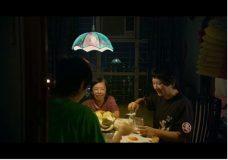
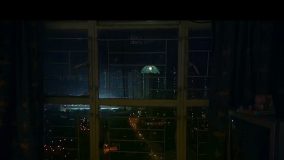
- Tin Shui Wai New Town: It was formerly part of the wetland system. Its ponds were later changed for fish and duck farming by the villagers. In 1982, government and a private developer jointly develop Tin Shui Wai for residential use to house a population of 135 000.
- According to Wojcik, P. R. (2010). The Apartment Plot:Urban Living in American Film and Popular Culture, 1945 to 1975 (pp. 6). Duke University Press.
- Leung looks outside and Guai is sleeping, then the shot backs to Leung who are still watching outside. The color of the setting has been changed to present different time. Clip2: https://www.youtube.com/watch?v=szTNW1no60A (from 3:41-4:12)
[506 words]
KUANG Yi, 3035950292
Appreciate your attempt to discuss the film’s presentation of “another side of Tin Shui Wai,” and “transportation and housing become props in the film.” Is this a description that you confirm during your fieldwork, be it an actual trip to the housing estate or a virtual trip via the blogs/vlogs of others who describe their experiences? Did you attempt to identify and visit physically or virtually the housing estate and/or the railway station and/or the elevated walkway in TSW new town to understand how the film has captured it and what was changed or manipulated to emphasize the plot narrative? If you did not conduct a field trip in person, did you do so virtually, i.e. “visit it” through other people (media reports, personal blogs, videos, etc.) who had done it? I particularly enjoy your study of how the “interior functions as a narrative device” in the sections on Leung’s room and the windows in Leung’s and Guai’s rooms.
Yes I had confirmed these descriptions after doing a virtual field trip to see the overview of TSW. In terms of “another side of Tin Shui Wai”, I made this statement since I found that TSW was described as a “horrible place” on media reports proposed by journalists. However, I found that the actual TSW is not as terrible as they described after conducting the virtual research. The movie is more similar to a documentary, reflecting a more realistic and “normal” TSW without eye-catching and odd stories. For “transportation and housing become props in the film”, I observed that no matter the railway stations or public estates in TSW are the places that people frequently go. But Hui used these elements as hints to suggest the time and characters’ economic situation. These normal elements help build a linkage between film and real life.